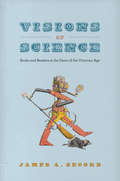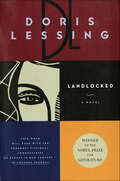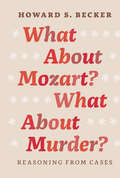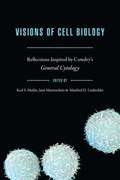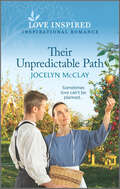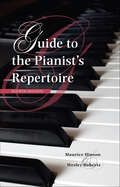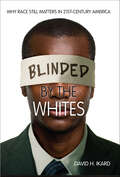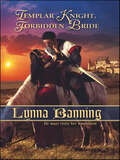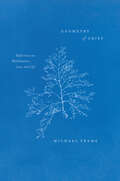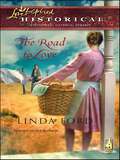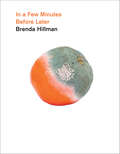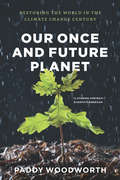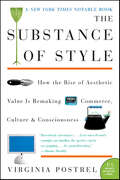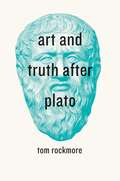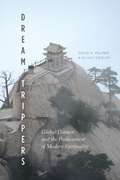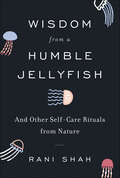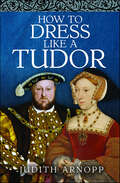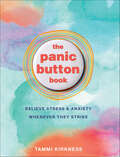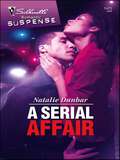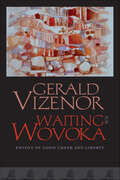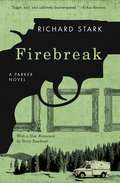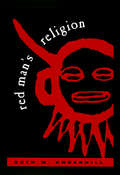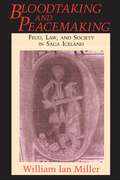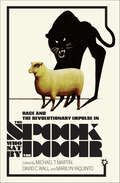- Table View
- List View
Visions of Science: Books and Readers at the Dawn of the Victorian Age
by James A. SecordThe first half of the nineteenth century witnessed an extraordinary transformation in British political, literary, and intellectual life. There was widespread social unrest, and debates raged regarding education, the lives of the working class, and the new industrial, machine-governed world. At the same time, modern science emerged in Europe in more or less its current form, as new disciplines and revolutionary concepts, including evolution and the vastness of geologic time, began to take shape. In Visions of Science, James A. Secord offers a new way to capture this unique moment of change. He explores seven key books—among them Charles Babbage’s Reflections on the Decline of Science, Charles Lyell’s Principles ofGeology, Mary Somerville’s Connexion of the Physical Sciences, and Thomas Carlyle’s Sartor Resartus—and shows how literature that reflects on the wider meaning of science can be revelatory when granted the kind of close reading usually reserved for fiction and poetry. These books considered the meanings of science and its place in modern life, looking to the future, coordinating and connecting the sciences, and forging knowledge that would be appropriate for the new age. Their aim was often philosophical, but Secord shows it was just as often imaginative, projective, and practical: to suggest not only how to think about the natural world but also to indicate modes of action and potential consequences in an era of unparalleled change. Visions of Science opens our eyes to how genteel ladies, working men, and the literary elite responded to these remarkable works. It reveals the importance of understanding the physical qualities of books and the key role of printers and publishers, from factories pouring out cheap compendia to fashionable publishing houses in London’s West End. Secord’s vivid account takes us to the heart of an information revolution that was to have profound consequences for the making of the modern world.
Landlocked (Children of Violence #4)
by Doris Lessing"Doris Lessing is the Cassandra of the documentary novel...crying for something harshly denied to our age: a longing for magic, for the irrational. Her concern for life, her independence of judgment and her gift for diagnosing our hydra-headed social ills is extraordinary." — The ObserverIn the aftermath of World War II, Martha Quest finds herself completely disillusioned. She is losing faith with the communist movement in Africa, and her marriage to one of the movement's leaders is disintegrating. Determined to resist the erosion of her personality, she engages in the first satisfactory love affair and breaks free, if only momentarily, from her suffocating unhappiness.Landlocked is the fourth novel of Doris Lessing's classic Children of Violence sequence of novels, each a masterpiece in its own right, and collectively an incisive, all encompassing vision of our world in the twentieth century.
What About Mozart? What About Murder?: Reasoning From Cases
by Howard S. BeckerIn 1963, Howard S. Becker gave a lecture about deviance, challenging the then-conventional definition that deviance was inherently criminal and abnormal and arguing that instead, deviance was better understood as a function of labeling. At the end of his lecture, a distinguished colleague standing at the back of the room, puffing a cigar, looked at Becker quizzically and asked, “What about murder? Isn’t that really deviant?” It sounded like Becker had been backed into a corner. Becker, however, wasn’t defeated! Reasonable people, he countered, differ over whether certain killings are murder or justified homicide, and these differences vary depending on what kinds of people did the killing. In What About Mozart? What About Murder?, Becker uses this example, along with many others, to demonstrate the different ways to study society, one that uses carefully investigated, specific cases and another that relies on speculation and on what he calls “killer questions,” aimed at taking down an opponent by citing invented cases. Becker draws on a lifetime of sociological research and wisdom to show, in helpful detail, how to use a variety of kinds of cases to build sociological knowledge. With his trademark conversational flair and informal, personal perspective Becker provides a guide that researchers can use to produce general sociological knowledge through case studies. He champions research that has enough data to go beyond guesswork and urges researchers to avoid what he calls “skeleton cases,” which use fictional stories that pose as scientific evidence. Using his long career as a backdrop, Becker delivers a winning book that will surely change the way scholars in many fields approach their research.
Visions of Cell Biology: Reflections Inspired by Cowdry's "General Cytology"
by Manfred D. LaubichlerAlthough modern cell biology is often considered to have arisen following World War II in tandem with certain technological and methodological advances—in particular, the electron microscope and cell fractionation—its origins actually date to the 1830s and the development of cytology, the scientific study of cells. By 1924, with the publication of Edmund Vincent Cowdry’s General Cytology, the discipline had stretched beyond the bounds of purely microscopic observation to include the chemical, physical, and genetic analysis of cells. Inspired by Cowdry’s classic, watershed work, this book collects contributions from cell biologists, historians, and philosophers of science to explore the history and current status of cell biology. Despite extraordinary advances in describing both the structure and function of cells, cell biology tends to be overshadowed by molecular biology, a field that developed contemporaneously. This book remedies that unjust disparity through an investigation of cell biology’s evolution and its role in pushing forward the boundaries of biological understanding. Contributors show that modern concepts of cell organization, mechanistic explanations, epigenetics, molecular thinking, and even computational approaches all can be placed on the continuum of cell studies from cytology to cell biology and beyond. The first book in the series Convening Science: Discovery at the Marine Biological Laboratory, Visions of Cell Biology sheds new light on a century of cellular discovery.
Their Unpredictable Path: An Uplifting Inspirational Romance
by Jocelyn McClayA young widower and an older widow get a second chance at love when they pretend to be in a relationship and fall in love for real.Falling for each other could ruin everything . . . Despite pressure from his parents, shy, stuttering widower Jethro Weaver does not want to remarry and has hatched the perfect plan—a fake courtship with an unsuitable partner. His senior by a decade, widow Susannah Mast has had enough of unwanted suitors and reluctantly agrees to Jethro’s scheme. But what happens when their fake relationship turns into something real?
Guide to the Pianist's Repertoire (Indiana Repertoire Guides)
by Maurice Hinson Wesley RobertsGuide to the Pianist's Repertoire continues to be the go-to source for piano performers, teachers, and students. Newly updated and expanded with more than 250 new composers, this incomparable resource expertly guides readers to solo piano literature and provides answers to common questions: What did a given composer write? What interesting work have I never heard of? How difficult is it? What are its special musical features? How can I reach the publisher? New to the fourth edition are enhanced indexes identifying black composers, women composers, and compositions for piano with live or recorded electronics; a thorough listing of anthologies and collections organized by time period and nationality, now including collections from Africa and Slovakia; and expanded entries to account for new material, works, and resources that have become available since the third edition, including websites and electronic resources. The "newest Hinson" will be an indispensible guide for many years to come.
Blinded by the Whites: Why Race Still Matters in 21st-Century America (Blacks in the Diaspora)
by David H. IkardThe election of Barack Obama gave political currency to the (white) idea that Americans now live in a post-racial society. But the persistence of racial profiling, economic inequality between blacks and whites, disproportionate numbers of black prisoners, and disparities in health and access to healthcare suggest there is more to the story. David H. Ikard addresses these issues in an effort to give voice to the challenges faced by most African Americans and to make legible the shifting discourse of white supremacist ideology—including post-racialism and colorblind politics—that frustrates black self-determination, agency, and empowerment in the 21st century. Ikard tackles these concerns from various perspectives, chief among them black feminism. He argues that all oppressions (of race, gender, class, sexual orientation) intersect and must be confronted to upset the status quo.
Templar Knight, Forbidden Bride
by Lynna BanningA hardened, battle-weary warrior, Reynaud has forgotten what it is to be in the company of a beautiful woman, to delight in her comfort and warmth.On his return to Granada, he is drawn to Leonor and senses that she could heal his hidden scars. She is set upon a dangerous path, a path that they travel together, becoming closer every day-every night. But such forbidden passion may be their undoing....
Geometry of Grief: Reflections on Mathematics, Loss, and Life
by Michael Frame&“With poignancy and audacity, Frame builds an unexpected bridge between mathematical beauty and human sorrow, illuminating both.&” —Francis Su, author of Mathematics for Human Flourishing We all know the euphoria of intellectual epiphany—the thrill of sudden understanding. But coupled with that excitement is a sense of loss: a moment of epiphany can never be repeated. In Geometry of Grief,mathematician Michael Frame draws on a career&’s worth of insight—including his work with a pioneer of fractal geometry Benoit Mandelbrot—as he delves into this understanding of loss. Grief, Frame reveals, can be a moment of possibility. Frame investigates grief as a response to an irrevocable change in circumstance. This reframing allows us to see parallels between the loss of a loved one and the loss of the elation of first understanding a tricky concept. From this foundation, Frame builds a geometric model of mental states. An object that is fractal, for example, has symmetry of magnification: magnify a picture of a mountain or a fern leaf—both fractal—and we see echoes of the original shape. Similarly, nested inside great loss are smaller losses. By manipulating this geometry, Frame shows us, we may be able to redirect our thinking in ways that help reduce our pain. Small-scale losses, in essence, provide laboratories to learn how to meet large-scale losses. Interweaving original illustrations, clear introductions to advanced topics in geometry, and wisdom gleaned from his own experience, Frame&’s poetic book is a journey through the beautiful complexities of mathematics and life. &“Intriguing.&” —Nature &“Poignant and beautiful. &“ —Steven Strogatz, New York Time– bestselling author of Infinite Powers &“A wonderful memoir.&” —Choice
The Road to Love
by Linda FordA Depression-era drifter helps a struggling widow care for her farm and family in this inspirational romance.The road that led to Kate Bradshaw's door sometimes seemed the loneliest in the world. In the depths of the Depression, the young widow was struggling to hold on to the family farm and raise two small children. And she had only her faith to sustain her—until the day Hatcher Jones came walking up that long, lonely road.The handsome, mysterious drifter was clearly haunted by some terrible secret from his past. But the simple acts of kindness he showed Kate and her children spoke of a good heart and strong values. And she longed to make him see that there could be redemption for anyone, even him—and that all his wandering had brought him home at last.
In a Few Minutes Before Later (Wesleyan Poetry Series)
by Brenda HillmanFinalist for the Four Quartets Prize, given by Poetry Society of America, 2023An iconoclastic ecopoet who has led the way for many young and emerging artists, Brenda Hillman continues to re-cast innovative poetic forms as instruments for tracking human and non-human experiences. At times the poet deploys short dialogues, meditations or trance techniques as means of rendering inner states; other times she uses narrative, documentary or scientific materials to record daily events during a time of pandemic, planetary crisis, political and racial turmoil. Hillman proposes that poetry offers courage even in times of existential peril; her work represents what is most necessary and fresh in American poetry. During an enchantment in the lifeDo you love a living person absolutely? Tell them now.In a half-unwieldy life you made, underthe hyaline sky, while the dead drank from zigzag pools nearby,if they saved you in your wild incapacities, in timing of the world's harmin a little pettiness in your own heart while others took your madrigals in shreds to a tribunal, when others said you should feel grateful to be minimally adequate for the world'striple exposure or some tired committee... The ones who love us, how do theybreak through our defenses? We're tired today. Come back later.Their baffled voices melting our wax wallswith a candle, the ones who understandwhat being is—the glowing, the broken,the wheels, the brave ones— they have their courage,you have yours,,,; when you meet the one you love,it is so rare. When you meetthe one who loves you, it is extremely rare.
Our Once and Future Planet: Restoring the World in the Climate Change Century
by Paddy WoodworthThe environmental movement is plagued by pessimism. And that’s not unreasonable: with so many complicated, seemingly intractable problems facing the planet, coupled with a need to convince people of the dangers we face, it’s hard not to focus on the negative But that paints an unbalanced—and overly disheartening—picture of what’s going on with environmental stewardship today. There are success stories, and Our Once and Future Planet delivers a fascinating account of one of the most impressive areas of current environmental experimentation and innovation: ecological restoration. Veteran investigative reporter Paddy Woodworth has spent years traveling the globe and talking with people—scientists, politicians, and ordinary citizens—who are working on the front lines of the battle against environmental degradation. At sites ranging from Mexico to New Zealand and Chicago to Cape Town, Woodworth shows us the striking successes (and a few humbling failures) of groups that are attempting to use cutting-edge science to restore blighted, polluted, and otherwise troubled landscapes to states of ecological health—and, in some of the most controversial cases, to particular moments in historical time, before widespread human intervention. His firsthand field reports and interviews with participants reveal the promise, power, and limitations of restoration. Ecological restoration alone won’t solve the myriad problems facing our environment. But Our Once and Future Planet demonstrates the role it can play, and the hope, inspiration, and new knowledge that can come from saving even one small patch of earth.
The Substance of Style: How the Rise of Aesthetic Value Is Remaking Commerce, Culture, and Consciousness
by Virginia PostrelWhether it's sleek leather pants, a shiny new Apple computer, or a designer toaster, we make important decisions as consumers every day based on our sensory experience. Sensory appeals are everywhere, and they are intensifying, radically changing how Americans live and work. The twenty-first century has become the age of aesthetics, and whether we realize it or not, this influence has taken over the marketplace, and much more.In this penetrating, keenly observed book, Virginia Postrel makes the argument that appearance counts, that aesthetic value is real. Drawing from fields as diverse as fashion, real estate, politics, design, and economics, Postrel deftly chronicles our culture's aesthetic imperative and argues persuasively that it is a vital component of a healthy, forward-looking society.Intelligent, incisive, and thought-provoking, The Substance of Style is a groundbreaking portrait of the democratization of taste and a brilliant examination of the way we live now.
Art and Truth after Plato
by Tom RockmoreDespite its foundational role in the history of philosophy, Plato’s famous argument that art does not have access to truth or knowledge is now rarely examined, in part because recent philosophers have assumed that Plato’s challenge was resolved long ago. In Art and Truth after Plato, Tom Rockmore argues that Plato has in fact never been satisfactorily answered—and to demonstrate that, he offers a comprehensive account of Plato’s influence through nearly the whole history of Western aesthetics. Rockmore offers a cogent reading of the post-Platonic aesthetic tradition as a series of responses to Plato’s position, examining a stunning diversity of thinkers and ideas. He visits Aristotle’s Poetics, the medieval Christians, Kant’s Critique of Judgment, Hegel’s phenomenology, Marxism, social realism, Heidegger, and many other works and thinkers, ending with a powerful synthesis that lands on four central aesthetic arguments that philosophers have debated. More than a mere history of aesthetics, Art and Truth after Plato presents a fresh look at an ancient question, bringing it into contemporary relief.
Dream Trippers: Global Daoism and the Predicament of Modern Spirituality
by David A. Palmer Elijah SieglerOver the past few decades, Daoism has become a recognizable part of Western “alternative” spiritual life. Now, that Westernized version of Daoism is going full circle, traveling back from America and Europe to influence Daoism in China. Dream Trippers draws on more than a decade of ethnographic work with Daoist monks and Western seekers to trace the spread of Westernized Daoism in contemporary China. David A. Palmer and Elijah Siegler take us into the daily life of the monastic community atop the mountain of Huashan and explore its relationship to the socialist state. They follow the international circuit of Daoist "energy tourism," which connects a number of sites throughout China, and examine the controversies around Western scholars who become practitioners and promoters of Daoism. Throughout are lively portrayals of encounters among the book’s various characters—Chinese hermits and monks, Western seekers, and scholar-practitioners—as they interact with each other in obtuse, often humorous, and yet sometimes enlightening and transformative ways. Dream Trippers untangles the anxieties, confusions, and ambiguities that arise as Chinese and American practitioners balance cosmological attunement and radical spiritual individualism in their search for authenticity in a globalized world.
Wisdom from a Humble Jellyfish: And Other Self-Care Rituals from Nature
by Rani ShahA delightfully illustrated guide to harnessing the rhythms of nature for self-care.We could all learn a thing or two about living in balance from our friends in the plant and animal kingdom. Take, for example, the jellyfish, one of the most energy-efficient animals in the world, moving through the ocean by contracting and relaxing, with frequent breaks in between. Or the avocado tree, which can credit its existence to a mutually beneficial relationship with the pre-historic sloth, followed by some hungry, hungry humans and the advent of agriculture. And then there is the oyster, producing a pearl as the result of an immune response when a grain of sand invades her system. What better example exists of how adversity can produce something beautiful?We need look no farther than nature—from the habits of the porcupine to the sunflower to the wombat to the dragonfly—for small and simple things we can do to slow down, recharge, and living more thoughtfully, lovingly, and harmoniously.Wisdom From a Humble Jellyfish . . . is at once charming and scientific, packed with essential wisdom and practical tips worth borrowing from our plant and animal friends for life-changing self-care.
How to Dress Like a Tudor
by Judith ArnoppThe perfect how-to guide for dressing like your favorite Tudor. Have you ever hankered to dress like a Tudor lord or lady, or perhaps you prefer the status of goodwife, or costermonger, or even a bawd? For beginner historical reenactors, the path to authenticity can be bewildering and sometimes intimidating. Judith Arnopp uses her own experience, both as a historian and a medieval/Tudor lady, to make your own journey a little easier. The author traces the transition of fashion from the relatively subtle styles popular at the court of Henry VII, through the carefully constructed royal grandeur of Henry VIII, Edward VI, and Mary I to the pinnacle of majesty and splendid iconography of Elizabeth I. In contrast to the magnificence of court come the ordinary folk who, subject to sumptuary laws and regulations, wore garments of a simpler cut and cloth – a strata of society that formed the back bone of Tudor England. This brief history of sixteenth century fashion examines clothing for both rich and poor, adult and child, and offers tips and tricks on how to begin to sew your first historically inspired garment, this book is aimed at helping the beginner learn How to Dress like a Tudor.
The Panic Button Book: Relieve Stress and Anxiety Whenever They Strike
by Tammi KirknessFrom a racing heart and dry mouth to shallow breathing and difficulty concentrating, anxiety can take many forms, but none of them are pleasant. The Panic Button Book is an anxiety first-aid kit, featuring simple exercises that can help alleviate common symptoms of panic, whenever and wherever they strike. The tried-and-tested techniques in this book will help you go from worry to relief, no matter what life throws your way.
A Serial Affair
by Natalie DunbarAgent Marina Santos ruined her relationship with Officer Reed Crawford when they first had dated. She never expected another chance. Until a vicious serial killer began terrorizing Chicago, and the two had to work together to track him down.Marina and Reed soon discovered a dark secret that might be the link between all the victims. And as they delved deeper, their steamy past added tension to the high-pressure investigation. Now they had to face their explosive feelings for one another, as well as the possibility that the victims may have gotten exactly what they deserved.
Waiting for Wovoka: Envoys of Good Cheer and Liberty
by Gerald VizenorIn the summer of 1962, a group of young Native American puppeteers travel in a converted school bus from the White Earth Reservation to the Century 21 Exposition, World's Fair in Seattle, Washington. The five Natives, three young men and two young women, have endured abandonment, abuse, poverty, and find solace, humor, and courage with a mute puppeteer—a Native woman in her seventies who writes original dream songs, and creates hand puppets and ironic parleys that mock the ghosts of authority. Dummy Trout, the mute puppeteer, also figured in Native Tributes and Satie on the Seine. The troupe attends a performance of Waiting for Godot by Samuel Beckett and they create a puppet parley for Wovoka, the inspiration of the Native American Ghost Dance Religion.
Firebreak: A Parker Novel
by Richard StarkA fortune in art awaits the master thief clever enough to steal it in this action-packed noir novel.Foreword by Terry TeachoutBetween Parker's 1961 debut and his return in the late 1990s, the whole world of crime changed. Now fake IDs and credit cards had to be purchased from specialists; increasingly sophisticated policing made escape and evasion tougher; and, worst of all, money had gone digital—the days of cash-stuffed payroll trucks were long gone.But cash isn't everything, not when a collection of priceless paintings is ripe for picking. In Firebreak, Parker travels to a palatial Montana “hunting lodge” where a dot-com millionaire hides a gallery of stolen old masters—which will fetch Parker a pretty penny if his team can just get it past the mansion's tight security. The forests of Montana are an inhospitable place for a heister when well-laid plans fall apart, but no matter how untamed the wilderness, Parker's guaranteed to be the most dangerous predator around.Praise for Richard Stark's Parker novels“The Parker novels are all superlative literary entertainments.” ―Terry Teachout, Weekly Standard“Parker is a brilliant invention. . . . What chiefly distinguishes Westlake, under whatever name, is his passion for process and mechanics. . . . [Parker] is a romantic vestige, a free-market anarchist whose independent status is becoming a thing of the past.” ―New York Times Book Review“Westlake knows precisely how to grab a reader, draw him or her into the story, and then slowly tighten his grip until escape is impossible.” ―Washington Post
Red Man's Religion: Beliefs and Practices of the Indians North of Mexico
by Ruth MurrayAmong the topics considered in this classic study are world origins and supernatural powers, attitudes toward the dead, the medicine man and shaman, hunting and gathering rituals, war and planting ceremonies, and newer religions, such as the Ghost Dance and the Peyote Religion. "The distinctive contribution of [Red Man's Religion] is the treatment of topics, the insight and the perspective of the author, and her ability to transmit these to the reader. . . . Trais and aspects of religion are not treated as abstract entitites, to be enumerated and summated, assigned a geographic distribution, and then abandoned. No page is a dry recital; each is an illumination. Insight and wisdom are framed in poetic prose. An offering of information in such a medium merits gratitude."—American Anthropologist
Bloodtaking and Peacemaking: Feud, Law, and Society in Saga Iceland
by William Ian MillerDubbed by the New York Times as "one of the most sought-after legal academics in the county," William Ian Miller presents the arcane worlds of the Old Norse studies in a way sure to attract the interest of a wide range of readers. Bloodtaking and Peacemaking delves beneath the chaos and brutality of the Norse world to discover a complex interplay of ordering and disordering impulses. Miller's unique and engaging readings of ancient Iceland's sagas and extensive legal code reconstruct and illuminate the society that produced them. People in the saga world negotiated a maze of violent possibility, with strategies that frequently put life and limb in the balance. But there was a paradox in striking the balance—one could not get even without going one better. Miller shows how blood vengeance, law, and peacemaking were inextricably bound together in the feuding process. This book offers fascinating insights into the politics of a stateless society, its methods of social control, and the role that a uniquely sophisticated and self-conscious law played in the construction of Icelandic society. "Illuminating."—Rory McTurk, Times Literary Supplement "An impressive achievement in ethnohistory; it is an amalgam of historical research with legal and anthropological interpretation. What is more, and rarer, is that it is a pleasure to read due to the inclusion of narrative case material from the sagas themselves."—Dan Bauer, Journal of Interdisciplinary History
Heaven and Earth Are Not Humane: The Problem of Evil in Classical Chinese Philosophy (World Philosophies)
by Franklin PerkinsThat bad things happen to good people was as true in early China as it is today. Franklin Perkins uses this observation as the thread by which to trace the effort by Chinese thinkers of the Warring States Period (c.475-221 BCE), a time of great conflict and division, to seek reconciliation between humankind and the world. Perkins provides rich new readings of classical Chinese texts and reflects on their significance for Western philosophical discourse.
Race and the Revolutionary Impulse in The Spook Who Sat by the Door (Studies in the Cinema of the Black Diaspora)
by Michael T. Martin, David C. Wall and Marilyn YaquintoIvan Dixon's 1973 film, The Spook Who Sat by the Door, captures the intensity of social and political upheaval during a volatile period in American history. Based on Sam Greenlee's novel by the same name, the film is a searing portrayal of an American Black underclass brought to the brink of revolution. This series of critical essays situates the film in its social, political, and cinematic contexts and presents a wealth of related materials, including an extensive interview with Sam Greenlee, the original United Artists' press kit, numerous stills from the film, and the original screenplay. This fascinating examination of a revolutionary work foregrounds issues of race, class, and social inequality that continue to incite protests and drive political debate.
